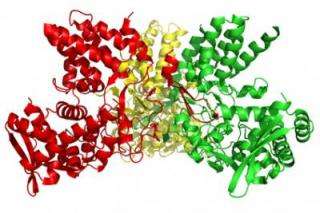December 2, 2016 report
Engineered virus has artificial amino acid allowing it to serve as a vaccine

(Medical Xpress)—A team of researchers at Peking University has developed a new type of vaccine that they claim may allow for a new approach to generating live virus vaccines which could conceivably be adapted to any type of virus. In their paper published in the journal Science, the team outlines the means by which they modified an influenza virus causing it to incite an immune response without a risk of infection.
Most vaccines today contain viruses that have been killed or weakened to the point that they are unlikely to cause an infection when injected into a healthy patient. Such vaccines work by causing the immune system to target similar viruses if found in the body before they have a chance to multiply, causing an infection. Unfortunately, in some cases, people with weak immune systems have found themselves experiencing a full-blown infection from a vaccine. In this new effort, the researchers took a new approach to creating a vaccine—modifying an influenza virus in such a way as disallow it from causing an infection in any patient.
The team started with the knowledge that viruses use certain amino acids as part of the infection process—they then modified an influenza virus by replacing one such amino acid with another that they had created in the lab—one that does not normally occur in viruses, or people. Without the right amino acid, the virus was still able to function, but it was unable to cause an infection—and because it was still a flu virus, its presence in the body caused the immune system to attack both them and any other type of flu virus encountered, thereby preventing an infection. In essence, it worked the same as a traditional vaccine without the risk of a patient experiencing an infection due to the vaccine.
The team reports that test vaccines they created were found to cause an antibody response in mice that was comparable to using a conventional vaccine. When test mice were vaccinated a second time at a later date, the researchers found that their antibodies were increased by a factor of six to eight. Furthermore, they found that the virus was effective in preventing flu infections in mice, ferrets and guinea pigs.
The team plans to continue their research by putting their vaccines through more rigorous testing before starting clinical trials.
More information: L. Si et al. Generation of influenza A viruses as live but replication-incompetent virus vaccines, Science (2016). DOI: 10.1126/science.aah5869
Abstract
The conversion of life-threatening viruses into live but avirulent vaccines represents a revolution in vaccinology. In a proof-of-principle study, we expanded the genetic code of the genome of influenza A virus via a transgenic cell line containing orthogonal translation machinery. This generated premature termination codon (PTC)–harboring viruses that exerted full infectivity but were replication-incompetent in conventional cells. Genome-wide optimization of the sites for incorporation of multiple PTCs resulted in highly reproductive and genetically stable progeny viruses in transgenic cells. In mouse, ferret, and guinea pig models, vaccination with PTC viruses elicited robust humoral, mucosal, and T cell–mediated immunity against antigenically distinct influenza viruses and even neutralized existing infecting strains. The methods presented here may become a general approach for generating live virus vaccines that can be adapted to almost any virus.
© 2016 Medical Xpress



















